GIS-Based Urban Afforestation Spatial Patterns and a Strategy for PM2.5 Removal
Abstract
:1. Introduction
2. Materials and Methods
2.1. Study Area and Data
2.2. Leaf Sample Collection
2.3. Analysis between PM2.5 Concentration and Adsorption by Leaves
2.4. Tree Planting Range
2.5. Tree Planting Plans
2.6. Effect of Planting Plan on PM2.5 Concentration
2.7. Plan Evaluation of Significance
2.8. Spatial Strategy of Afforestation
3. Results
3.1. Regularity between PM2.5 Concentration and Adsorption by Leaves
3.2. Plans of Planting
3.3. Effects of Plans on PM2.5 Concentration
3.4. Planting Spatial Pattern
4. Discussion
4.1. Afforestation Strategy and Policy Implications
4.2. Evaluation of the Methods in This Paper
4.2.1. Sample Selection
4.2.2. Measuring Method
4.2.3. GIS-Based Forest Spatial Distribution
4.3. Limitations and Prospects
5. Conclusions
Author Contributions
Funding
Acknowledgements
Conflicts of Interest
References
- Deng, T.T.; Wang, D.D.; Yang, Y.; Yang, H. Shrinking cities in growing China: Did high speed rail further aggravate urban shrinkage? Cities 2019, 86, 210–219. [Google Scholar] [CrossRef]
- Li, C.; Li, H.J.; Feng, S.D.; Liu, X.Y.; Guo, S. A study on the spatiotemporal characteristics and change trend of the atmospheric environmental carrying capacity in the Jing-Jin-Ji region, China. J. Clean. Prod. 2019, 211, 27–35. [Google Scholar] [CrossRef]
- Xiao, H.J.; Duan, Z.Y.; Zhou, Y.; Zhang, N.; Shan, Y.L.; Lin, X.Y.; Liu, G.S. CO2 emission patterns in shrinking and growing cities: A case study of Northeast China and the Yangtze River Delta. Appl. Energ. 2019, 251, 113384. [Google Scholar] [CrossRef]
- Wang, J.; Hu, Z.M.; Chen, Y.Y.; Chen, Z.L.; Xu, S.Y. Contamination characteristics and possible sources of PM10 and PM2.5 in different functional areas of Shanghai, China. Atmos. Environ. 2013, 68, 221–229. [Google Scholar] [CrossRef]
- Yin, H.; Xu, L.Y. Comparative study of PM10/PM2.5-bound PAHs in downtown Beijing, China: Concentrations, sources, and health risks. J. Clean. Prod. 2018, 177, 674–683. [Google Scholar] [CrossRef]
- Lelieveld, J.; Evans, J.S.; Fnais, M.; Giannadaki, D.; Pozzer, A. The contribution of outdoor air pollution sources to premature mortality on a global scale. Nature 2015, 525, 367–371. [Google Scholar] [CrossRef] [PubMed]
- Shao, F.; Wang, L.H.; Sun, F.B.; Li, G.; Yu, L.; Wang, Y.J.; Zeng, X.R.; Yan, H.; Dong, L.; Bao, Z.Y. Study on different particulate matter retention capacities of the leaf surfaces of eight common garden plants in Hangzhou, China. Sci. Total Environ. 2019, 652, 939–951. [Google Scholar] [CrossRef] [PubMed]
- Pope, C.A.; Burnett, R.T.; Thun, M.J.; Calle, E.E.; Krewski, D.; Ito, K.; Thurston, G.D. Lung cancer, cardiopulmonary mortality, and long-term exposure to fine particulate air pollution. J. Am. Med. Assoc. 2002, 287, 1132–1141. [Google Scholar] [CrossRef]
- Irga, P.J.; Burchett, M.D.; Torpy, F.R. Does urban forestry have a quantitative effect on ambient air quality in an urban environment? Atmos. Environ. 2015, 120, 173–181. [Google Scholar] [CrossRef] [Green Version]
- Zhang, X.D.; Du, J.; Huang, T.; Zhang, L.M.; Gao, H.; Zhao, Y.; Ma, J.M. Atmospheric removal of PM2.5 by man-made Three Northern Regions Shelter Forest in Northern China estimated using satellite retrieved PM2.5 concentration. Sci. Total Environ. 2017, 593–594, 713–721. [Google Scholar] [CrossRef]
- Xie, C.K.; Kan, L.Y.; Guo, J.K.; Jin, S.J.; Li, Z.G.; Chen, D.; Li, X.; Che, S.Q. A dynamic processes study of PM retention by trees under different wind conditions. Environ. Pollut. 2018, 233, 315–322. [Google Scholar] [CrossRef] [PubMed]
- Zhang, Y.J.; Hao, J.F. The evaluation of environmental capacity: Evidence in Hunan province of China. Ecol. Indic. 2016, 60, 514–523. [Google Scholar] [CrossRef]
- Zhou, Y.J.; Zhou, J.X. Urban atmospheric environmental capacity and atmospheric environmental carrying capacity constrained by GDP and PM2.5. Ecol. Indic. 2017, 73, 637–652. [Google Scholar] [CrossRef]
- McDonald, A.G.; Bealey, W.J.; Fowler, D.; Dragosits, U.; Skiba, U.; Smith, R.I.; Donovan, R.G.; Brett, H.E.; Hewitt, C.N.; Nemitz, E. Quantifying the effect of urban tree planting on concentrations and depositions of PM10 in two UK conurbations. Atmos. Environ. 2007, 41, 8455–8467. [Google Scholar] [CrossRef]
- Tallis, M.; Taylor, G.; Sinnett, D.; Freer-Smith, P. Estimating the removal of atmospheric particulate pollution by the urban tree canopy of London, under current and future environments. Landsc. Urban Plan. 2011, 103, 129–138. [Google Scholar] [CrossRef]
- Janhall, S. Review on urban vegetation and particle air pollution—Deposition and dispersion. Atmos. Environ. 2015, 105, 130–137. [Google Scholar] [CrossRef]
- Nowak, D.J.; Hirabayashi, S.; Doyle, M.; McGovern, M.; Pasher, J. Air pollution removal by urban forests in Canada and its effect on air quality and human health. Urban For. Urban Gree. 2018, 29, 40–48. [Google Scholar] [CrossRef]
- Yang, T.R.; Liu, W.L. Does air pollution affect public health and health inequality? Empirical evidence from China. J. Clean. Prod. 2018, 203, 43–52. [Google Scholar] [CrossRef]
- Wuhan national economic and social development statistical bulletin in 2018. Hubei provincial bureau of statistics (HBS). Available online: http://tjj.hubei.gov.cn/tjsj/ndtjgb/fzndtjgb/120429.htm (accessed on 30 August 2019).
- Liu, Z.; Chen, D.; Huo, X.X.; Yin, J.; Mei, Y. Lag effects of air pollutant levels on pediatric respiratory disease outpatient visits in Wuhan. J. Environ. Occup. Med. 2018, 35, 124–130, (In Chinese with English abstract). [Google Scholar] [CrossRef]
- Wuhan Garden and Forestry Bureau (WGFB). Wuhan’s greening status report, 2017 (in Chinese). Available online: http://www.wuhan.gov.cn/whszfwz/xwxx/whyw/201803/t20180322_192625.html (accessed on 29 August 2019).
- Chen, L.X.; Wang, L.Q.; Li, G.; Ma, F.W.; Zhang, Z.Q. Understanding treescape changes as the basis of urban forest planning infringe areas. Ecol. Indic. 2018, 95, 117–126. [Google Scholar] [CrossRef]
- Sun, C.G.; Lin, T.; Zhao, Q.J.; Li, X.H.; Ye, H.; Zhang, G.Q.; Liu, X.F.; Zhao, Y. Spatial pattern of urban green spaces in a long-term compact urbanization process—A case study in China. Ecol. Indic. 2019, 96, 111–119. [Google Scholar] [CrossRef]
- Mincey, S.; Schmitt-Harsh, M.; Thurau, R. Zoning, land use, and urban tree canopy cover: The importance of scale. Urban For. Urban Gree. 2013, 12, 191–199. [Google Scholar] [CrossRef]
- Ordonez, C.; Duinker, P. An analysis of urban forest management plans in Canada: Implications for urban forest management. Landsc. Urban Plan. 2013, 116, 36–47. [Google Scholar] [CrossRef] [Green Version]
- Mabon, L.; Shih, W.Y. What might ‘just green enough’ urban development mean in the context of climate change adaptation? The case of urban greenspace planning in Taipei Metropolis, Taiwan. World Dev. 2018, 107, 224–238. [Google Scholar] [CrossRef]
- Wu, R.W. The development of urban green space in foreign countries. City Plan. Rev. 1998, 22, 39–43. (In Chinese) [Google Scholar]
- Fan, P.P.; Xu, L.H.; Yue, W.Z.; Chen, J.Q. Accessibility of public urban green space in an urban periphery: The case of Shanghai. Landsc. Urban Plan. 2017, 165, 177–192. [Google Scholar] [CrossRef]
- Luz, A.C.; Buijs, M.; Aleixo, C.; Metelo, I.; Grilo, F.; Branquinho, C.; Santos-Reis, M.; Pinho, P. Should I stay or should I go? Modelling the fluxes of urban residents to visit green spaces. Urban For. Urban Gree. 2019, 40, 195–203. [Google Scholar] [CrossRef]
- Fan, C.; Johnston, M.; Darling, L.; Scott, L.; Liao, F.H. Land use and socio-economic determinants of urban forest structure and diversity. Landsc. Urban Plan. 2019, 181, 10–21. [Google Scholar] [CrossRef]
- Chen, C. Layout status and optimal site selection of urban disaster prevention green space: A case study of Shenyang central urban area. Ph.D Thesis, Northeast Normal University, Changchun, China, 2016. (In Chinese with English abstract). [Google Scholar]
- Escobedo, F.; Nowak, D.J. Spatial heterogeneity and air pollution removal by an urban forest. Landsc. Urban Plan. 2009, 90, 102–110. [Google Scholar] [CrossRef]
- Chen, M.; Dai, F.; Yang, B.; Zhu, S.W. Effects of urban green space morphological pattern on variation of PM2.5 concentration in the neighborhoods of five Chinese megacities. Build. Environ. 2019, 158, 1–15. [Google Scholar] [CrossRef]
- Meerow, S.; Newell, J.P. Spatial planning for multifunctional green infrastructure: Growing resilience in Detroit. Landsc. Urban Plan. 2017, 59, 62–75. [Google Scholar] [CrossRef]
- Sass, C.K.; Lodder, R.A.; Lee, B.D. Combining biophysical and socioeconomic suitability models for urban forest planning. Urban For. Urban Gree. 2019, 38, 371–382. [Google Scholar] [CrossRef]
- Pugh, T.A.M.; MacKenzie, A.M.; Whyatt, J.D.; Hewitt, C.N. Effectiveness of green infrastructure for improvement of air quality in urban street canyons. Environ. Sci. Technol. 2012, 46, 7692–7699. [Google Scholar] [CrossRef] [PubMed]
- Wuhan Planning & Design Institute (WPDI). Wuhan’s 2049 Vision of Development Strategy, 2017 (In Chinese). Available online: http://www.wpdi.cn/project-1-i_11297.htm (accessed on 23 July 2019).
- Nowak, D.J.; Hirabayashi, S.; Bodine, A.; Greenfield, E. Tree and forest effects on air quality and human health in the United States. Environ. Pollut. 2014, 193, 119–129. [Google Scholar] [CrossRef] [PubMed] [Green Version]
- Huang, Z.G.; Ding, Z.J.; Yao, J.; Pan, L.; Pan, Y.P.; Jiang, T.P.; Wu, H.Z.; Shi, G.W. Investigation on plant diversity resources in Wuhan city. Gree Technol. 2006, 102, 32–38. (In Chinese) [Google Scholar]
- Jia, Y.; Wu, C.; Dong, C.F.; Li, C.P.; Liao, H.M. Measurement on ability of dust removal of seven green plants at micro-conditions. J. Cent. South Univ. 2012, 43, 4547–4553, (In Chinese with English abstract). [Google Scholar]
- Tomasevic, M.; Vukmirovic, Z.; Rajsic, S.; Tasic, M.; Stevanovic, B. Characterization of trace metal particles deposited on some deciduous tree leaves in an urban area. Chemosphere 2005, 61, 753–760. [Google Scholar] [CrossRef] [PubMed]
- Wang, L.; Gong, H.L.; Liao, W.B.; Wang, Z. Accumulation of particles on the surface of leaves during leaf expansion. Sci. Total Environ. 2015, 532, 420–434. [Google Scholar] [CrossRef]
- Zhang, L.; Zhang, Z.Q.; Chen, L.X.; McNulty, S. An investigation on the leaf accumulation-removal efficiency of atmospheric particulate matter for five urban plant species under different rainfall regimes. Atmos. Environ. 2019, 208, 123–132. [Google Scholar] [CrossRef]
- Lu, S.W.; Yang, X.B.; Li, S.N.; Chen, B.; Jiang, Y.; Wang, D.; Xu, L. Effects of plant leaf surface and different pollution levels on PM2.5 adsorption capacity. Urban For. Urban Gree. 2018, 34, 64–70. [Google Scholar] [CrossRef]
- Ministry of Natural Resources of the People Republic of China (MNR). Current Land Use Classification (GB/T 21010-2017). 2017; (In Chinese). Available online: http://www.mnr.gov.cn/dt/ywbb/201810/t20181030_2288891.html (accessed on 29 August 2019).
- Wuhan Garden and Forestry Bureau (WGFB). Wuhan’s 13th Five-year Plan of Garden and Forestry Development. 2017; (In Chinese). Available online: http://ylj.wuhan.gov.cn/webpage/view/breakNews.jsp?article_id=6172&from=singlemessage&isappinstalled=0 (accessed on 26 September 2019).
- Nowak, D.J.; Hirabayashi, S.; Bodine, A.; Hoehn, R. Modeled PM2.5 removal by trees in ten U.S. cities and associated health effects. Environ. Pollut. 2013, 178, 395–402. [Google Scholar] [CrossRef] [PubMed]
- Chen, X.P.; Jiao, Y.W.; Pei, T.T.; Zhou, Z.X. The effect of adsorbing fine particulate matter (PM2.5) by garden plants: A review. Chin. J. Ecol. 2014, 33, 2558–2566, (In Chinese with English abstract). [Google Scholar] [CrossRef]
- National Forestry and Grassland Administration (NFGA). National Technical Provisions on Continuous Inventory of Forest Resources. 2014; (In Chinese). Available online: http://www.forestry.gov.cn/main/4818/content-797022.html (accessed on 23 July 2019).
- Dzierzanowski, K.; Popek, R.; Gawroska, H.; Sӕbø, A.; Gawronski, S.W. Deposition of particulate matter of different size fractions on leaf surfaces and in waxes of urban forest species. Int. J. Phytoremediat. 2011, 13, 1037–1046. [Google Scholar] [CrossRef] [PubMed]
- Sӕbø, A.; Popek, R.; Nawrot, B.; Hanslin, H.M.; Gawronska, H.; Gawronski, S.W. Plant species differences in particulate matter accumulation on leaf surfaces. Sci. Total Environ. 2012, 427, 347–354. [Google Scholar] [CrossRef] [PubMed]
- Jamil, S.; Abhilash, P.C.; Singh, A.; Singh, N.; Behl, H.M. Fly ash trapping and metal accumulating capacity of plants: Implication for green belt around thermal power plants. Landsc. Urban Plan. 2009, 92, 136–147. [Google Scholar] [CrossRef]
- Pontes, D.M.; Engel, V.L.; Parrotta, J. Forest structure, wood standing stock, and tree biomass in different restoration systems in the Brazilian Atlantic Forest. Forests 2019, 10, 588. [Google Scholar] [CrossRef]
- Muhammad, S.; Wuyts, K.; Samson, R. Atmospheric net particle accumulation on 96 plant species with contrasting morphological and anatomical leaf characteristics in a common garden experiment. Atmos. Environ. 2019, 202, 328–344. [Google Scholar] [CrossRef]

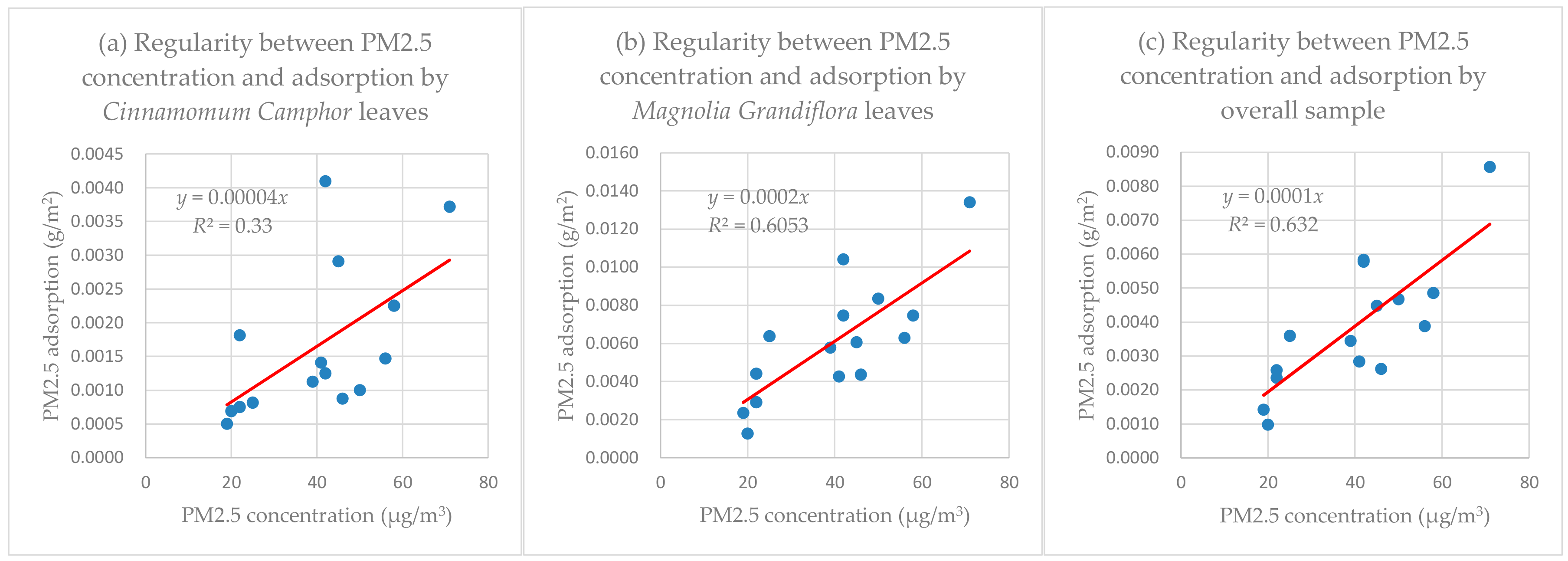
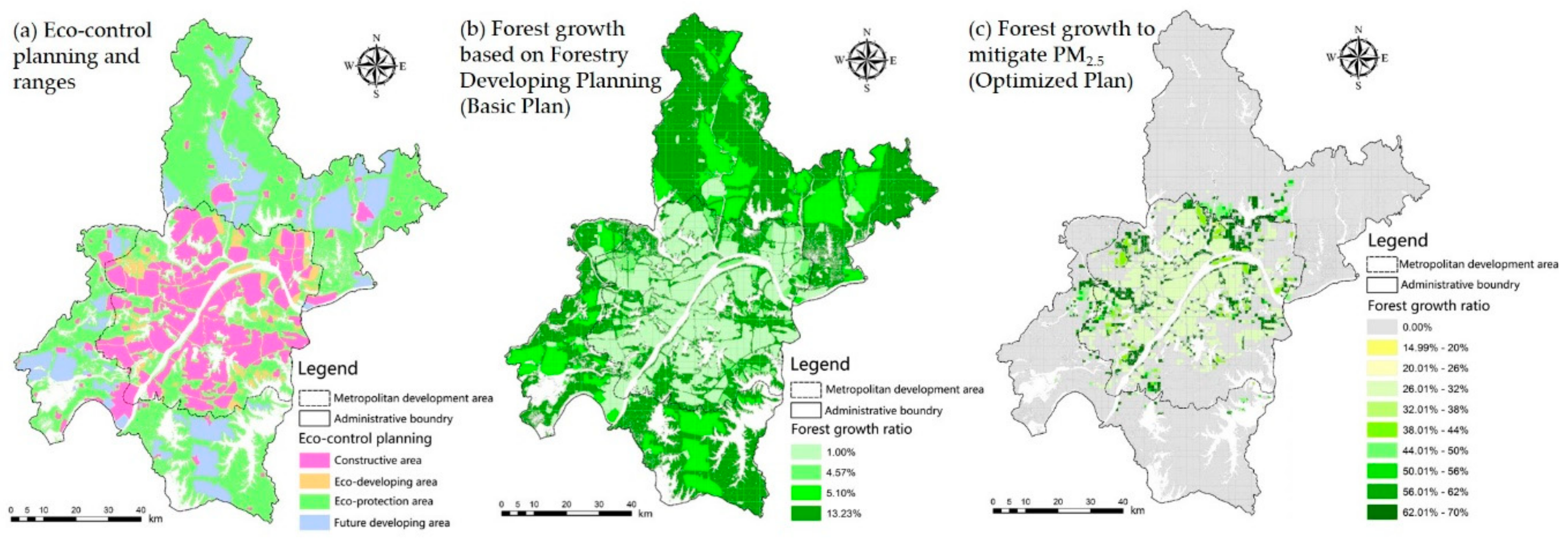

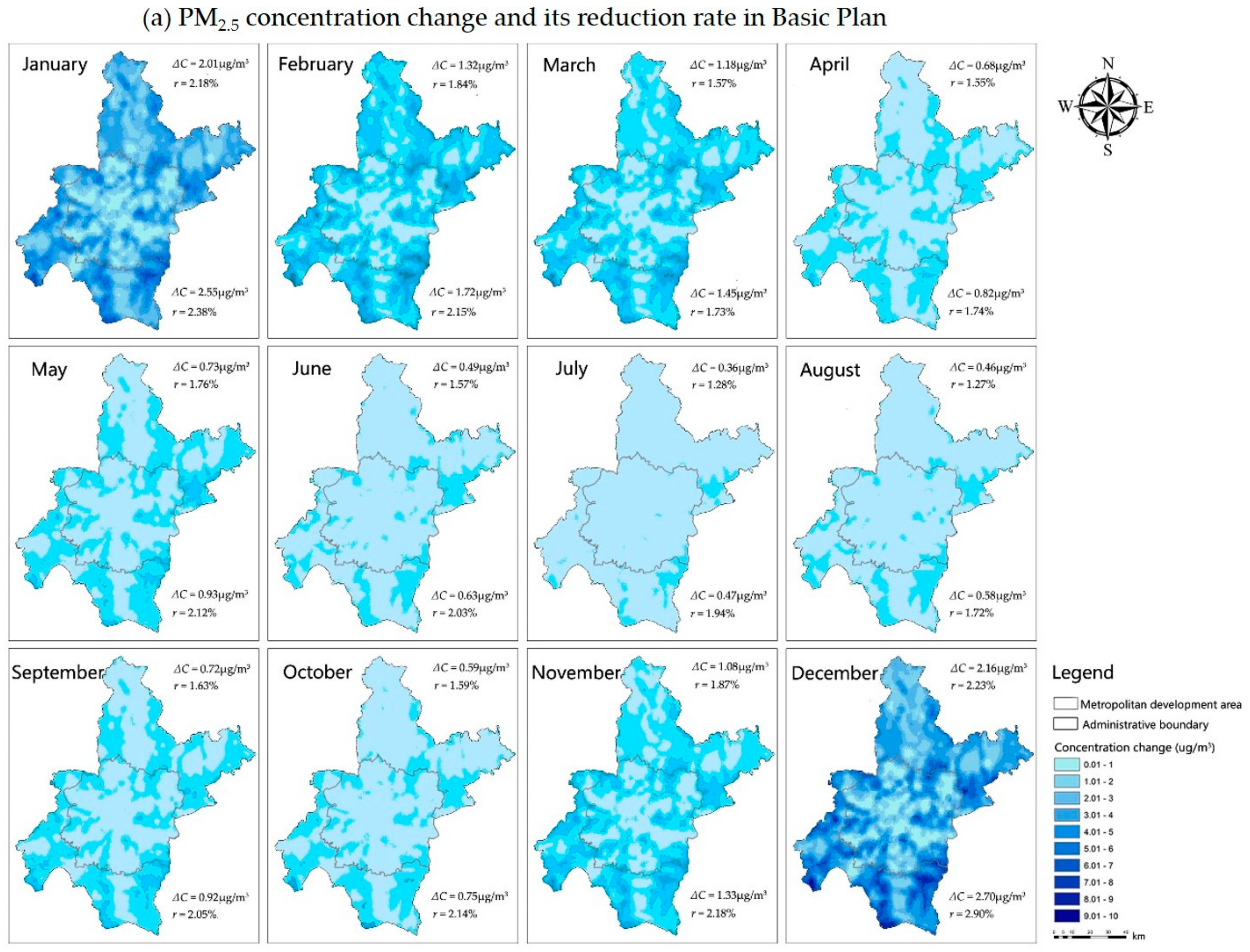
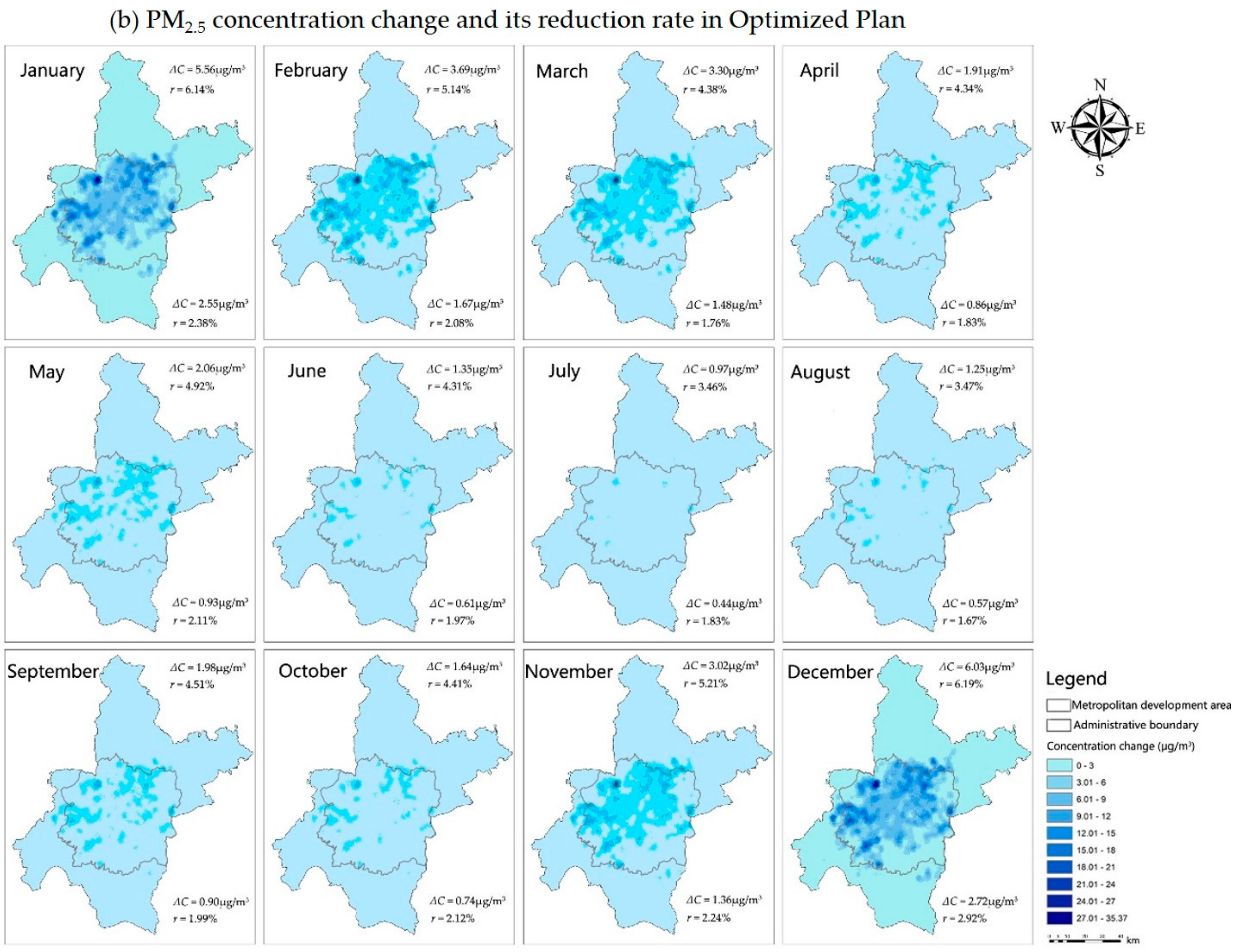
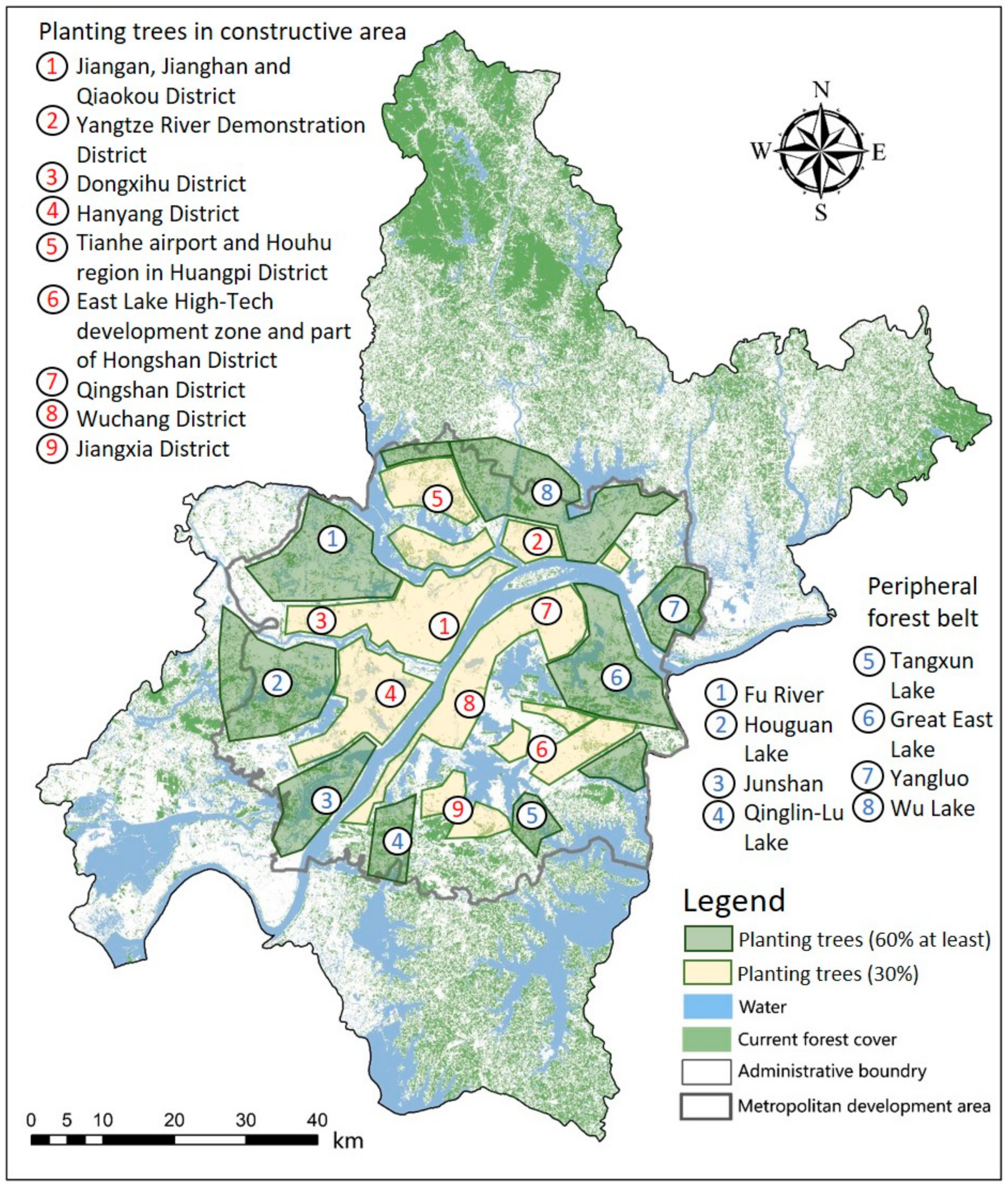
| PM2.5 Concentration (μg m−3) | Cinnamomum Camphor | Magnolia Grandiflora | Overall Sample | |||||||
|---|---|---|---|---|---|---|---|---|---|---|
| Time | 3 day | 2 day | 1 day | hour | W-PM2.5 | M-PM2.5 | W-PM2.5 | M-PM2.5 | W-PM2.5 | M-PM2.5 |
| 11 May | 42 | 48 | 45 | 31 | 0.0023 | 0.0029 | 0.0032 | 0.0060 | 0.0028 | 0.0045 |
| 13 May | 55.6 | 61 | 58 | 33 | 0.0018 | 0.0023 | 0.0040 | 0.0075 | 0.0029 | 0.0048 |
| 14 May | 64.3 | 64.5 | 71 | 68 | 0.0030 | 0.0037 | 0.0071 | 0.0134 | 0.0051 | 0.0086 |
| 16 May | 46 | 33.5 | 41 | 44 | 0.0011 | 0.0014 | 0.0023 | 0.0043 | 0.0017 | 0.0028 |
| 17 May | 36.3 | 41.5 | 42 | 45 | 0.0010 | 0.0012 | 0.0055 | 0.0104 | 0.0033 | 0.0058 |
| 18 May | 40.6 | 40.5 | 39 | 25 | 0.0009 | 0.0011 | 0.0031 | 0.0058 | 0.0020 | 0.0034 |
| 19 May | 35.3 | 32 | 25 | 20 | 0.0007 | 0.0008 | 0.0034 | 0.0064 | 0.0020 | 0.0036 |
| 20 May | 28.3 | 23.5 | 22 | 16 | 0.0006 | 0.0007 | 0.0023 | 0.0044 | 0.0015 | 0.0026 |
| 21 May | 29.6 | 32 | 42 | 60 | 0.0033 | 0.0041 | 0.0040 | 0.0075 | 0.0036 | 0.0058 |
| 22 May | 40 | 49 | 56 | 96 | 0.0012 | 0.0015 | 0.0034 | 0.0063 | 0.0023 | 0.0039 |
| 23 May | 48 | 51 | 46 | 46 | 0.0007 | 0.0009 | 0.0023 | 0.0044 | 0.0015 | 0.0026 |
| 24 May | 50.6 | 48 | 50 | 49 | 0.0008 | 0.0010 | 0.0045 | 0.0083 | 0.0026 | 0.0047 |
| 27 May | 19.6 | 16 | 20 | 16 | 0.0005 | 0.0007 | 0.0007 | 0.0013 | 0.0006 | 0.0010 |
| 28 May | 17 | 19.5 | 19 | 29 | 0.0004 | 0.0005 | 0.0013 | 0.0023 | 0.0008 | 0.0014 |
| 29 May | 20.3 | 20.5 | 22 | 36 | 0.0014 | 0.0018 | 0.0016 | 0.0029 | 0.0015 | 0.0023 |
© 2019 by the authors. Licensee MDPI, Basel, Switzerland. This article is an open access article distributed under the terms and conditions of the Creative Commons Attribution (CC BY) license (http://creativecommons.org/licenses/by/4.0/).
Share and Cite
Zhou, Y.; Liu, H.; Zhou, J.; Xia, M. GIS-Based Urban Afforestation Spatial Patterns and a Strategy for PM2.5 Removal. Forests 2019, 10, 875. https://doi.org/10.3390/f10100875
Zhou Y, Liu H, Zhou J, Xia M. GIS-Based Urban Afforestation Spatial Patterns and a Strategy for PM2.5 Removal. Forests. 2019; 10(10):875. https://doi.org/10.3390/f10100875
Chicago/Turabian StyleZhou, Yejing, Helin Liu, Jingxuan Zhou, and Meng Xia. 2019. "GIS-Based Urban Afforestation Spatial Patterns and a Strategy for PM2.5 Removal" Forests 10, no. 10: 875. https://doi.org/10.3390/f10100875





